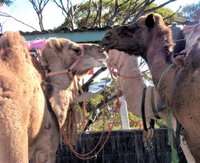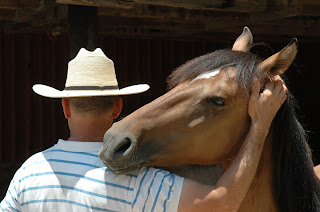Mini Camel Caravan
 During the time I lived in Eucla, Western Australia (population: 40-something; 1429 km from Perth; 1222 km from Adelaide), I edited a little newsletter, The Eucla Telegraph, with a distribution between Nullarbor, SA, and Perth. I often included a feature story on a local resident, event or happening. One day, after having worked at the Eucla Motor Hotel from 6 AM to 1 PM, I was at home when someone phoned saying a chap with four camels and a dog had just arrived at the roadhouse. I picked up my pen, notebook and camera and headed over there—just a few 100 metres. This story, which has been edited for inclusion here, is what appeared in the June 2001 newsletter.
During the time I lived in Eucla, Western Australia (population: 40-something; 1429 km from Perth; 1222 km from Adelaide), I edited a little newsletter, The Eucla Telegraph, with a distribution between Nullarbor, SA, and Perth. I often included a feature story on a local resident, event or happening. One day, after having worked at the Eucla Motor Hotel from 6 AM to 1 PM, I was at home when someone phoned saying a chap with four camels and a dog had just arrived at the roadhouse. I picked up my pen, notebook and camera and headed over there—just a few 100 metres. This story, which has been edited for inclusion here, is what appeared in the June 2001 newsletter.Chris Richards has been trekking the past three months through the Western Australian outback, ‘learning heaps’, raising a little money for the Royal Flying Doctor Service, and heading toward Fowler’s Bay. There, he hopes to acquire more camels and begin a trek up to and along the Dog Fence with paying customers who want to see the land in a unique way. [The Dog Fence was finalised to its current single-line form in 1946 to keep feral animals, especially dingoes, away from sheep stations. It runs from the Great Australian Bight north to the Bunya Mountains in southeast Queensland, a distance of about 5400 km—two and a half times longer than the Great Wall of China.]
 From Perth he travelled along the water pipeline to Kalgoorlie, making about 20-30 km per day. Then he followed the rail line from Kalgoorlie to Rawlinna and Forrest. He intended to continue east along the train line, but was advised by Andrew and Mandy Forte (owners of the operation at Forrest, which includes the only sealed airstrip in the area) to head south to Eucla, as the road east that had already caused him and his camels much trouble would just get worse. In addition, there are larger numbers of bull camels in that direction, and three of his camels are females, just beginning to come into season with the cooler weather. “I’d hate to have to shoot a [wild] camel just because he was messing with my camels”, Chris said.
From Perth he travelled along the water pipeline to Kalgoorlie, making about 20-30 km per day. Then he followed the rail line from Kalgoorlie to Rawlinna and Forrest. He intended to continue east along the train line, but was advised by Andrew and Mandy Forte (owners of the operation at Forrest, which includes the only sealed airstrip in the area) to head south to Eucla, as the road east that had already caused him and his camels much trouble would just get worse. In addition, there are larger numbers of bull camels in that direction, and three of his camels are females, just beginning to come into season with the cooler weather. “I’d hate to have to shoot a [wild] camel just because he was messing with my camels”, Chris said.Camels were introduced to Australia in the 1800s to provide transportation in its hot, dry central deserts. With the completion of rail lines east and west, north and south and the introduction of petrol-powered transportation, camels were no longer a convenient means of transporting goods, so many herds were either destroyed or turned loose. Australia’s feral camel herds now are among the last remaining wild herds on earth. It is estimated that feral camels in Australia may number up to about 500,000. An adult camel can weigh 250-680 kg and grow to more than 2 metres tall. They can live up to 50 years and breed actively for about 30 of those years.
While well adapted to desert living and able to eat salt bush or plants with thorns and even high toxic content that native species cannot eat; they can go without water when vegetation is plentiful, but represent a danger to native species when they damage water holes. Because they are able to reach about 3.5 metres for vegetation, they can destroy native trees. They also destroy fences and are susceptible to tuberculosis and brucellosis, making them an infection danger to domestic livestock. However, their padded feet do less damage to soil and ground cover than livestock, and they do not represent a danger of feeding intensely in one area because they are always on the move. They represent the biggest problem when their numbers are large.

Chris purchased his camels from some friends who had a herd of about 15. The big, dark brown male is blind, and “will try to kill you, or at least bite you” if you’re not careful. The smallest of the four camels tries to kick him all the time. The largest female is blind in her right eye, and number four is just noisy. Camels are very intelligent, Chris noted, but stubborn. And after a pause, as if he were deciding if he should say, he admitted, “And camel is very good eating”.
“Do you threaten them with that when they’re giving you a hard time”, I asked. He admitted he’d thought of it, but “if I ate one, and another one got sick, then I’d be down to two camels. And I’m not carrying all that gear myself!”
His six-month old kelpie-cross dog, Bungee, “is mad as a cut snake”, Chris says, chasing rabbits, kangaroos of all sizes, and some very large feral cats. Once in the chase, he doesn’t hear Chris calling him. Just that morning, he'd been taught "a nearly nasty lesson by a very large red kangaroo male". A large kangaroo, although ordinarily timid, is dangerous when at bay, able to pummel its attacker with its forepaws and slash with its powerful hind legs. But so far, Bungee is enjoying the trip, and even helps nip a camel or two when they are misbehaving. Bungee wears a wire muzzle to keep him from eating fox baits. “He wouldn’t like it much in the city,” I suggest. “No”, Chris agreed. “He’d be eating tyres and chasing buses, I reckon”. Then he added, after a bit of thought, “I’ll try to keep him away from places like that.”
When I left them, Chris was enjoying his second cigarette, after a refreshing shower. “I haven’t had one of these for a month,” he announced, as he opened a newly purchased pack after finishing off a hamburger with the lot (cheese, salad, egg, pineapple and bacon). “No, that’s a lie”, he admitted. “I had one after dinner up at Forrest the other day”. I suggested that it might be a good time to quit, and he admitted that it might be true. But he just wasn’t going to do that right now.
 “How far is the ocean from here” he asked me at one point. When I pointed out that it was just four kilometres from the roadhouse, he thought for a moment and then decided he’d wait to see the ocean until they got to Fowler’s Bay (about another 150 km). “I’m really looking forward to seeing the ocean”. I told him that he could see the view, at least, at the back to the Eucla Motor Hotel. But he was holding out for Fowler’s Bay. He gave Bungee a nudge with the toe of his well-worn athletic shoe and said, “I’ll take ol’ Bung’ for a swim when we get to Fowler’s Bay”.
“How far is the ocean from here” he asked me at one point. When I pointed out that it was just four kilometres from the roadhouse, he thought for a moment and then decided he’d wait to see the ocean until they got to Fowler’s Bay (about another 150 km). “I’m really looking forward to seeing the ocean”. I told him that he could see the view, at least, at the back to the Eucla Motor Hotel. But he was holding out for Fowler’s Bay. He gave Bungee a nudge with the toe of his well-worn athletic shoe and said, “I’ll take ol’ Bung’ for a swim when we get to Fowler’s Bay”.He gave me his mother’s address in Geelong, Victoria, so I could send him a copy of the Telegraph with this story in it. He planned to head east, to South Australia, soon after he finished that second cigarette. Without thinking, I warned him, “You’ll lose 45 minutes when you cross the border.” Then I thought better of it. “I don’t guess 45 minutes makes much difference to you, does it?”
“No”, he admitted. “We get up when it’s light and go to sleep when it’s dark.”

Comments